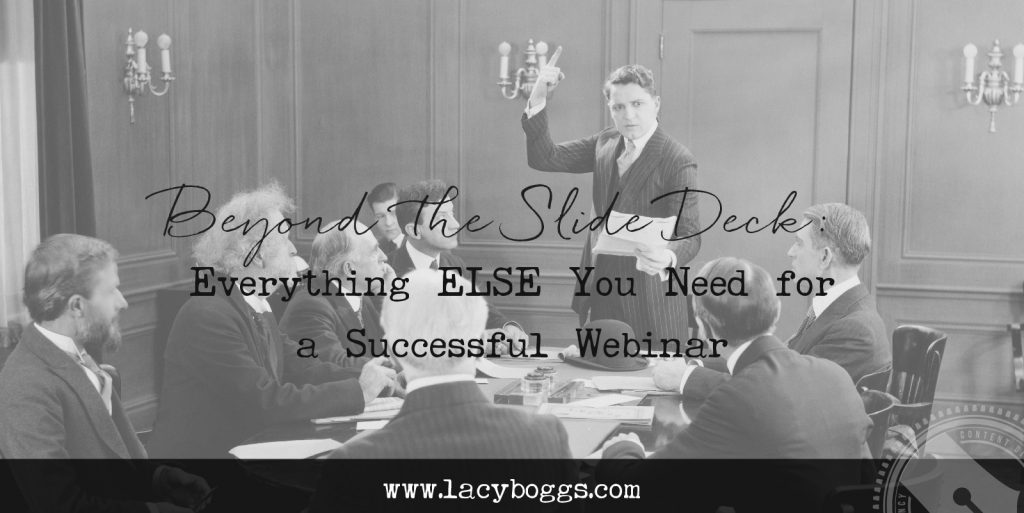You’re planning a webinar to add new subscribers to your email list, to promote an affiliate offer, or to sell your latest and greatest thing.
You’ve got a gorgeous slide deck, you’ve practiced your presentation and your pitch is on point.
You’ve even tested your tech extensively and made sure there will be no gremlins interrupting you on webinar day.
But delivering a successful webinar goes way beyond having a pretty slide deck, an interesting presentation, and a strong pitch.
In fact, there’s a TON of additional content you need to create to support your webinar and ensure that it helps you reach your goals — like invitation and promo emails, a landing page and a thank you page, social media posts, attendance emails, and sales emails after the pitch.
It can seem like a lot… But there’s also a good reason you want to create the right kinds of content to support your webinar: better registration numbers, better attendance, and better conversion rates and sales.
Content you need to create to support a webinar
The types of collateral content you need to support a webinar depends on who is delivering the webinar content. You have one list of needs if you are presenting the webinar, and a slightly different list if a guest is coming in to do a presentation for your audience. Here’s a short checklist I use for both circumstances:
Webinar FOR my audience by someone else:
(Content delivered by a partner.)
- Landing page link from partner
- Affiliate link from partner
- Promo email swipe from partner (if applicable)
- Write/Edit promo email
- Schedule and send promo email(s) to list
- Write social posts
- Schedule social posts
Webinar BY me (for my own audience or someone else’s):
(Content delivered by me.)
- Create landing page
- Create/update Thank You page
- Set up partner as affiliate
- Set up webinar with tool of choice
- Write promo emails/swipe file and send to partner
- Create promos for my list (if applicable)
- Create follow-up email sequence
As you can see, there’s quite a bit of collateral needed even for a simple webinar. But let’s talk about the emails specifically; how many emais do you actually need and what should they say?
How many emails do you need?
When you are the one delivering the presentation (and the pitch) for a webinar, you are in charge of not only getting people to sign up, but getting them to SHOW UP.
First, you’ll need several promotional emails that you will send to your list or that your partner will send to her list advertising the webinar and enticing people to sign up. I usually bank on 2-3 promotional emails, especially if a partner is introducing you to their audience.
As soon as people sign up for the webinar, however, it becomes your responsibility to get them to attend.
It’s a fact of digital life that people sign up for webinars and then don’t show up to attend them live — or ever even watch the replay. If you’re seeing a low rate of people showing up live for your webinars, you probably need to send MORE emails to encourage and excite them to get ready and actually show up and participate.
After the webinar, you’ll want to send a series of follow up emails sharing the replay (if you choose to offer one), reiterating the sales pitch, overcoming objections, and reminding people of any deadlines.
Overall, you might have anywhere from one to two dozen emails to support a single webinar — and that’s a lot of content!
Emails before the webinar
As an example, let’s take a look at what a robust attendance-boosting sequence might look like for a typical webinar. These are the emails you send after someone has registered for the webinar.
I have had 50-70% attendance rates for webinars in the past using this sequence for emails, so while it may seem like a lot, it truly works:
Email 1: You’re Registered
Remind them of the date/time, and keep this one short.
Immediate
Email 2: Prepping for webinar + freebie
Give them some free content you have that’s relevant to the webinar topic & give them a freebie deliverable for registering. (ie: a workbook, template, etc.)
4 days prior
Email 3: What to expect
Let them know what you will cover, and be benefit-specific to incentivize them to show up.
2 days prior
Email 4: Webinar is tomorrow
Keep this one short, and tell them why YOU’re excited about tomorrow’s webinar.
1 day prior
Email 5: Webinar starts in 1 hour
Send a short reminder with the webinar link, but don’t put any other links in the email.
1 hour prior
Email 6: Webinar starts in 15 mins
Send a short(er) reminder with the webinar link, but don’t put any other links in the email.
15 mins prior
This is especially important if you open up registration for the webinar more than a couple of days in advance. In general, the more time that lapses between when a person signs up and when the event takes place, the more emails you need to entice and remind them to attend.
After the webinar happens, that’s when you start sending the follow-up and sales emails. You might choose to have as few as two or three, or as many as 12 follow up emails, based on many different factors including the length of your sales period, the price of your offer, how familiar your audience is with you and your products, etc.
The point is, in my experience, many business owners are sending far too few emails to support their webinars. But when you add a bit more content and communication, you can improve registration rates, attendance rates, and conversion rates without ever changing the content of your webinar.

